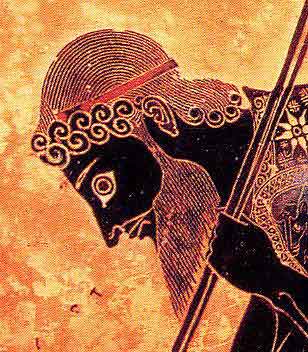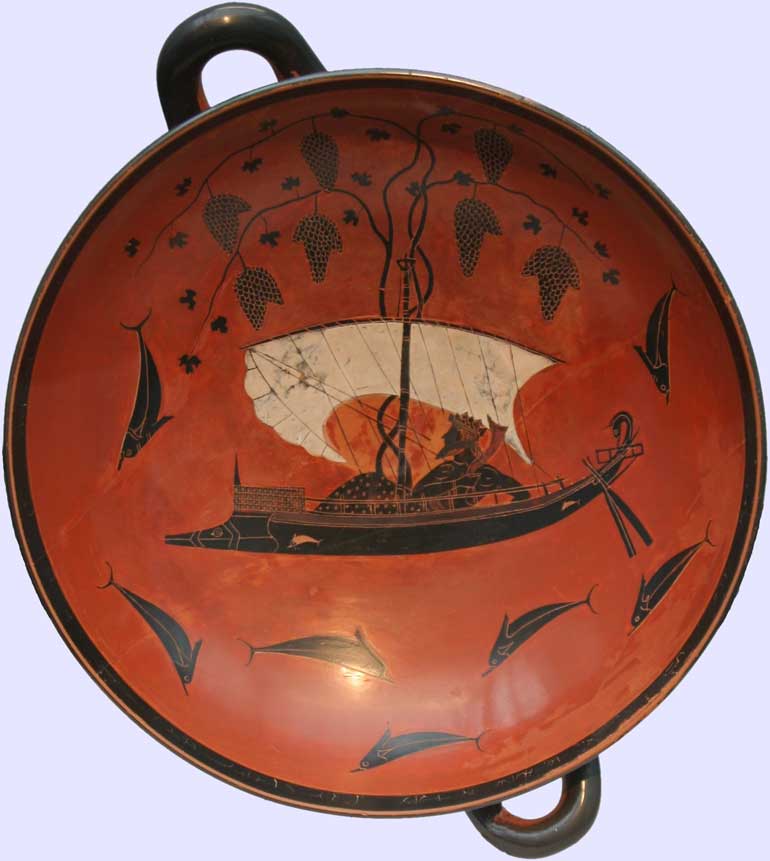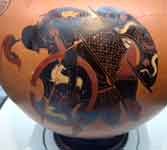.

Head and Shoulders of Ajax
Exekias (a Greek name) or Execias (Latinization) was an ancient Greek vase-painter and potter, who worked between approximately 550 BC - 525 BC at Athens. The pottery, however, was exported to other regions, such as Etruria. Exekias worked mainly with the technique called black-figure. It was only used for a relatively short time and dates his floruit. He is considered the best or one of the best of the black-figure vase painters.
Background
The works of Exekias are distinguished by their grand compositions, precise draughtsmanship and subtle characterisation, transcending the inherent limitations of the black-figure technique. As one historian of Greek art has said,
"the hallmark of his style is a near statuesque dignity which brings vase painting for the first time close to claiming a place as a major art" (John Boardman, Athenian Black Figure Vases, 1974).
He was an innovative painter and potter, experimenting with new shapes and devising unusual techniques such as a coral-red wash to enhance colour.

Ajax and Achilles playing a game, an invention of Exekias, undocumented in literature
Eleven signed works by Exekias have survived and approximately another 25 vessels and plaques have been attributed to him. His best-known work is an amphora, now on display in the Vatican Museums in Rome, which depicts Ajax and Achilles playing a game at Troy; it is inscribed with the words
"Eksekias egraphse kapoiese me"
"Exekias made and decorated me."
Other works also showed scenes from the Trojan War, such as Achilles slaying Penthesilea, Queen of the Amazons, or Ajax preparing to commit suicide. Perhaps his most famous work, appearing almost without fail in every text on Greek art, is a kylix (drinking cup), inside which is depicted the picture of the god of wine Dionysus on a vessel. It bears the signature
"Eksekias epoiese"
"Exekias made (me)"
These vases are masterpieces; however, only a few are extant. It seems unlikely that he could have earned a living on those few carefully crafted pieces. He may well have produced large numbers of less carefully made, unsigned pots for general consumption.
No details of his life survive, from which one might conclude to a contemporary social insignificance (perhaps not a severe as that of Van Gogh). It has been deduced from his preference for themes on Ajax that he was from Salamis.

Achilles and Penthesilea, BM B209
Themes
Exekias was interested in the depiction of grand moments in life, death and religion, rather than in the details of mythology. His paintings are carefully staged pauses in the cinema of life, showing close-ups of the characters at symbolic moments. He was the tragedian of vase-painting. His painting is analogous to what in literature would be called the high style.

The Dionysos kylix uses the bottom of a wine bowl as a working surface for the main scenario. Dionysos was the god of inspiration. The painting depicts the initial journey of Dionysos to Athens by ship. Pirates had seized the ship and were going, perhaps, to sell Dionysos into slavery. Instead the god caused vines to grow from the mast, frightening the pirates so much that they jumped overboard and were changed into dolphins.
The most important element of the theme is that the pirates were not assassinated. They were subordinated and now frolic around the ship in attendance on the god. Dionysos intends to bring order by divine inspiration to Athens, which, like the rest of the Aegean lands, has suffered piracy, banditry and social chaos during the Greek "dark ages." In the painting, god glides serenely over the cosmos, which grows and lives at his bidding, and frolics in attendance upon him. The white sails draw attention to the wind, which blows where god wills it, in this case to Athens. The journey of Dionysos has been described as a nostos, a return home.
The amphora shown in this article presents Achilles and Ajax at a moment of concentration upon a game in the middle of a battle. The nature of the game is not known. Some compare it to chess or checkers; others, to dice. The postures of the warriors show that they are not relaxing, but are hanging on the outcome of the game. War is a game, whether of strategy or of chance. Both men are caught up in a game for which they did not make the rules, and are trying to influence its outcome in their favor.
Another vase shows Penthesilea at the moment of her slaughter. Her face and arms are white, the symbol of femininity. She looks up with pathos at the man who now has her totally at his mercy. She is overpowered by nature, but her weapons, her femininity and her spear, have failed. Some say that in that moment she and Achilles are shown falling in love, but too late for love and mercy. This is an ironic contrast between what was and what should have been. It is a statement about women going to war, which Greek society viewed as out of place.
The suicide of Ajax portrays a moment not all that rare among professional military men. Ajax has been passed over for promotion in favor of Odysseus and now, if he cannot win the honor on which he has set his mind, he will not live. Warriors seek honor and glory (kleos) on the battlefield by killing others. Now the warrior whose kleos has failed off the battlefield kills himself.
The shield decorated with the protecting Gorgoneion has been laid aside. Ajax is now vulnerable. He plants the sword of destruction in the earth, crouching over it, turning his back on the tree of life. Shortly he will fall on the sword.

Eight women and a child who lost his mother, Exekias
Composition
Exekias tries to fill the entire surface of the pot with decoration as thickly as he can. And yet, each of the scenarios is carefully bordered; that is, he seems to follow a principle of cosmic order.
In addition to the main tableau are subordinate ones. Where there are no tableaux, he uses rows of rosettes, spikes, spirals and plain bands. Sometimes he surrounds the main tableau with simple black, so that it appears suddenly, out of the darkness, so to speak.
It is diagnostic of Exekias that he uses the shape of the vessel and its protrusions as a terrain to which the lines and forms of the painting conform. As you gaze directly at the tableau, a center of attention appears: the game board, the face of Penthesilea, the starry robe of Dionysos, the sword implanted in the earth. In the round surface of the vase, this point is closest to the eye and is seen directly on.
All the other main lines are either concentric around the thematic center or lead to it as the spokes of a wheel: the spears of the warriors, the curved backs of their hunching forms, the wind-filled sails of the ship and its curved bottom, the circle of dolphins, etc.
Detail
A second diagnostic of Exekias is that he fills the outlines of his figures densely with carefully incised lines showing a microcosm of detail, especially in the clothes and armor of the characters. No other Greek vase painter does that.
The detail of the clothing is a repetition on a smaller scale of themes found over the vase as a whole. One cannot fail to wonder, for example, at the embellishments on the head and shoulders of the Ajax, shown above, all the more so when one realizes that the object is only an earthen pot. It should have been gold inlaid with niello, which heightens the mystery of Exekias.

Ajax with Achilles, Staatliche Antikensammlungen 1470 side A.
Links
Toby Schreiber , Athenian Vase Costruction: A Potter's Analysis , J. Paul Getty Trust Publications (May, 1999) ISBN: 0892364653
John Boardman , Athenian Black Figure Vases (World of Art) , Thames & Hudson; Reprint edition (February, 1985) ISBN: 0500201382
John Boardman , Early Gree Vase Painting, 11th-6th Centuries BC: A Handbook (World of Art) ,Thames & Hudson (May, 1998) ISBN: 0500203091
John Boardman, Athenian Red Figure Vases: The Classical Period: A Handbook (World of Art) by John Boardman (1989) Paperback , Thames & Hudson (December 1989)
See also
Pottery of Ancient Greece
Greeks:
A - B - C - D - E - F - G - H - I - J - K - L - M -
N - O - P - Q - R - S - T - U - V - W - X - Y - Z
Artist
A - B - C - D - E - F - G - H - I - J - K - L - M -
N - O - P - Q - R - S - T - U - V - W - X - Y - Z
| Ancient Greece
Science, Technology , Medicine , Warfare, , Biographies , Life , Cities/Places/Maps , Arts , Literature , Philosophy ,Olympics, Mythology , History , Images Medieval Greece / Byzantine Empire Science, Technology, Arts, , Warfare , Literature, Biographies, Icons, History Modern Greece Cities, Islands, Regions, Fauna/Flora ,Biographies , History , Warfare, Science/Technology, Literature, Music , Arts , Film/Actors , Sport , Fashion --- |
Retrieved from "http://en.wikipedia.org"
All text is available under the terms of the GNU Free Documentation License

